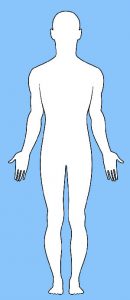 Have you ever looked in the mirror and noticed one shoulder may be lower then the other? Or have you ever noticed your friend’s head is way too forward? Or have you ever look at someone else and noticed they have a “hump” in the upper back? Or has someone ever told you that you slouch when you’re standing?
Have you ever looked in the mirror and noticed one shoulder may be lower then the other? Or have you ever noticed your friend’s head is way too forward? Or have you ever look at someone else and noticed they have a “hump” in the upper back? Or has someone ever told you that you slouch when you’re standing?
These are just some of the many types of postural imbalances that are common in people, adults, teens and children alike.
Postural imbalances or postural displacements can cause strain and stress on spinal bones, nerves and muscles. This can lead aches, pain, fatigue and even a decrease in body function and health.
What is normal ideal posture? What does normal posture look like? Read on …
Normal Posture

Looking at someone from the front view, these body parts should line up in a normal standing position: mid forehead (midpoint between eyes) lines up midpoint of the upper lip, the midpoint of the chin, the midpoint of the sternum (chest bone) and the midpoint of pelvis). See Figure A.
Looking at someone from the side view, these body parts should line up: the ear is in line with the mid shoulder, the mid hip and the ankle. See Figure B.
With this in mind, how does your posture look? At end of the this article, you will see a link where you can do a Posture Self Test.
Why is keeping an optimal posture important?

An optimal ideal posture is essential to living stress-free, pain-free and as healthy as possible. Here are some statements from posture-related research:
“Posture and normal physiology and function are inter-related.” 1.
“Abnormal posture is evident in patients with chronic pain-related conditions including backache, headache, and stress-related illnesses.” 1.
“Posture affects all human function, both consciously and unconsciously, from breathing to thinking.” 1.
“When postural efficiency is optimized, not only is breathing and vocal resonance maximized, but all other responsive functions of the body-mind also improve. How one uses the body-mind instrument in relation to the invariable forces of gravity establishes the effectiveness of all psychosomatic human function and environmental interaction. Optimal oxygenation provides not only one means of minimizing undesirable tension throughout the body…but also forms a neurophysiologic pathway to improve overall health and well-being.” 1.
What can a chiropractor do about posture problems?
The chiropractor’s objective is to optimize one’s health and well-being. Therefore, many chiropractors examine and correct for any posture imbalances. Optimal posture and optimal spinal alignment is essential for normal bodily function and for overall health and well-being. This is true for people of all ages, including children and teens.
If you have any questions about your posture or if you are looking for a thorough posture check-up, seek for and talk to a chiropractor in your community.
Keep in mind, one does not have to have pain or symptoms with postural imbalances. Pain and symptoms are often the last to appear. It is always a good idea to get a thorough posture and spinal check-up by a chiropractor if you suspect any postural problems. Many postural imbalances and displacements can be corrected well before they become worse. So early detection of posture displacements is key, especially in children and teens.
If you are in the Maple, Vaughan area, call our office if you have any questions or to see how chiropractic can help. At Back To Health Chiropractic Centre, we examine and measure people’s postural imbalances and provide individualized and specific exercises for correction.
